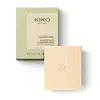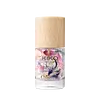What's inside
What's inside
 Key Ingredients
Key Ingredients

 Benefits
Benefits

 Concerns
Concerns

 Ingredients Side-by-side
Ingredients Side-by-side

Sodium Cocoyl Isethionate
CleansingHydrogenated Vegetable Oil
EmollientWater
Skin ConditioningPolyglyceryl-4 Laurate
EmulsifyingKaolin
AbrasiveGlycerin
HumectantParfum
MaskingLactic Acid
BufferingZinc Oxide
Cosmetic ColorantTetrasodium Glutamate Diacetate
Aloe Barbadensis Leaf Juice
Skin ConditioningHydrolyzed Moringa Oleifera Seed Extract
Skin ConditioningHexyl Cinnamal
PerfumingBenzyl Salicylate
PerfumingCoumarin
PerfumingLinalool
PerfumingAlpha-Isomethyl Ionone
PerfumingSodium Salicylate
PreservativePotassium Sorbate
PreservativeSodium Cocoyl Isethionate, Hydrogenated Vegetable Oil, Water, Polyglyceryl-4 Laurate, Kaolin, Glycerin, Parfum, Lactic Acid, Zinc Oxide, Tetrasodium Glutamate Diacetate, Aloe Barbadensis Leaf Juice, Hydrolyzed Moringa Oleifera Seed Extract, Hexyl Cinnamal, Benzyl Salicylate, Coumarin, Linalool, Alpha-Isomethyl Ionone, Sodium Salicylate, Potassium Sorbate
Caprylic/Capric Triglyceride
MaskingPrunus Amygdalus Dulcis Oil
Skin ConditioningSilica Dimethyl Silylate
EmollientHelianthus Annuus Seed Oil
EmollientPhenoxyethanol
PreservativeParfum
MaskingTocopheryl Acetate
AntioxidantRosa Canina Fruit Oil
EmollientIsostearyl Isostearate
EmollientCentaurea Cyanus Flower
Skin ConditioningXerochrysum Bracteatum Flower
Skin ConditioningBenzotriazolyl Dodecyl P-Cresol
UV AbsorberPEG-8
HumectantCaprylyl Glycol
EmollientTocopherol
AntioxidantNelumbo Nucifera Flower Extract
Skin ConditioningAscorbyl Palmitate
AntioxidantAscorbic Acid
AntioxidantCitric Acid
BufferingCI 60725
Cosmetic ColorantMek
PerfumingBenzyl Salicylate
PerfumingHexyl Cinnamal
PerfumingGeraniol
PerfumingLinalool
PerfumingCitronellol
PerfumingHydroxycitronellal
PerfumingCaprylic/Capric Triglyceride, Prunus Amygdalus Dulcis Oil, Silica Dimethyl Silylate, Helianthus Annuus Seed Oil, Phenoxyethanol, Parfum, Tocopheryl Acetate, Rosa Canina Fruit Oil, Isostearyl Isostearate, Centaurea Cyanus Flower, Xerochrysum Bracteatum Flower, Benzotriazolyl Dodecyl P-Cresol, PEG-8, Caprylyl Glycol, Tocopherol, Nelumbo Nucifera Flower Extract, Ascorbyl Palmitate, Ascorbic Acid, Citric Acid, CI 60725, Mek, Benzyl Salicylate, Hexyl Cinnamal, Geraniol, Linalool, Citronellol, Hydroxycitronellal
Ingredients Explained
These ingredients are found in both products.
Ingredients higher up in an ingredient list are typically present in a larger amount.
Benzyl Salicylate is a solvent and fragrance additive. It is an ester of benzyl alcohol and salicylic acid. This ingredient can be naturally found in some plants and plant extracts.
In fragrances, Benzyl Salicylate may be a solvent or a fragrance component. In synthetic musk scents, it is used as a solvent. For floral fragrances such as lilac and jasmine, it is used as a fragrance component. The natural scent of Benzyl Salicylate is described as "lightly-sweet, slightly balsamic".
While Benzyl Salicylate has been associated with contact dermatitis and allergies, emerging studies show it may not be caused by this ingredient alone.
However, this ingredient is often used with fragrances and other components that may cause allergies. It is still listed as a known allergen in the EU. We recommend speaking with a professional if you have concerns.
Another study from 2021 shows Benzyl Salicylate may have anti-inflammatory properties.
Learn more about Benzyl SalicylateHexyl Cinnamal is a fragrance ingredient with a similar scent to jasmine. It can be naturally found in chamomile essential oil.
This ingredient is a known EU allergen and may sensitize the skin. The EU requires this ingredient to be listed separately on an ingredients list.
Hexyl Cinnamal is not water soluble but is soluble in oils.
Learn more about Hexyl CinnamalLinalool is a fragrance and helps add scent to products. It's derived from common plants such as cinnamon, mint, citrus, and lavender.
Like Limonene, this ingredient oxidizes when exposed to air. Oxidized linalool can cause allergies and skin sensitivity.
This ingredient has a scent that is floral, spicy tropical, and citrus-like.
Learn more about LinaloolParfum is a catch-all term for an ingredient or more that is used to give a scent to products.
Also called "fragrance", this ingredient can be a blend of hundreds of chemicals or plant oils. This means every product with "fragrance" or "parfum" in the ingredients list is a different mixture.
For instance, Habanolide is a proprietary trade name for a specific aroma chemical. When used as a fragrance ingredient in cosmetics, most aroma chemicals fall under the broad labeling category of “FRAGRANCE” or “PARFUM” according to EU and US regulations.
The term 'parfum' or 'fragrance' is not regulated in many countries. In many cases, it is up to the brand to define this term.
For instance, many brands choose to label themselves as "fragrance-free" because they are not using synthetic fragrances. However, their products may still contain ingredients such as essential oils that are considered a fragrance by INCI standards.
One example is Calendula flower extract. Calendula is an essential oil that still imparts a scent or 'fragrance'.
Depending on the blend, the ingredients in the mixture can cause allergies and sensitivities on the skin. Some ingredients that are known EU allergens include linalool and citronellol.
Parfum can also be used to mask or cover an unpleasant scent.
The bottom line is: not all fragrances/parfum/ingredients are created equally. If you are worried about fragrances, we recommend taking a closer look at an ingredient. And of course, we always recommend speaking with a professional.
Learn more about Parfum